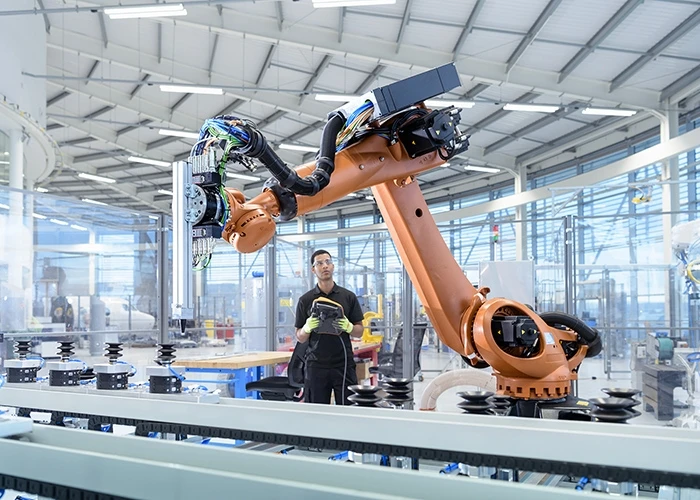& Construction

Integrated BIM tools, including Revit, AutoCAD, and Civil 3D
& Manufacturing

Professional CAD/CAM tools built on Inventor and AutoCAD
Some of the world’s most successful athletes share a simple secret. In the heat of play, they don’t dwell on where the ball is; they anticipate where it’s going to be and then do what it takes to get there.
That’s a useful metaphor for today’s digital workplace. Technology is ripping up the job descriptions for current roles and creating a need for new ones. To succeed, business leaders need a workforce ready for what’s likely to come tomorrow. That’s what upskilling and reskilling aims to achieve: nimble, digital-savvy teams that can light up the scoreboard by adapting to changing conditions and turning opportunity into advantage.
In simple terms, upskilling and reskilling are both processes of people constantly adding new skills they can apply to their workplace, either as their job changes or in preparation for a promotion. That’s not new, but the seismic shifts happening within digital transformation have applied a new urgency to upskilling. Digitally based business models require a fully modernized workforce with skill sets and competencies for evolving roles and responsibilities. That need cuts across sectors and is vital to the success of organizations and their employees.
Before the pandemic, US manufacturers were planning to invest $26 billion on upskilling in 2021; COVID-19 obviously shelved many plans and altered priorities. But the necessary, accelerated adoption of digital tools and platforms that resulted highlighted how many operational practices were ripe for change.
The digital upskilling of the past two years has helped manufacturing businesses adapt and thrive in a period of disruption. It also helped dispel some myths about software “eating the world.”
Following the COVID-19 pandemic's mass upskilling wave, some of the key takeaways:
Automation and robots are eliminating rote and repetitive tasks, not jobs. By 2025, automation alone is forecast to create 12 million new jobs.
However, 50% of employees will need to upskill as a result. That means both employees and employers must embrace the principle of lifelong learning.
This learning of new skills is likely to be a positive factor in employee retention. Some 94% of employees say they’ll stay longer with a company that invests in their career.
Digital technologies have been disrupting the workplace and creating demand for new skills since the term digital transformation was coined a decade ago. A pre-pandemic McKinsey study estimated that the rapid spread of artificial intelligence and automation would compel close to 375 million workers (14% of the global workforce) to change jobs or acquire new competencies by 2030.
COVID-19 has turned the necessity of operating digitally into a virtue. The rapid leap to working remotely, collaborating virtually, and relying more heavily on data and analytics to meet customer needs has become the operational blueprint for manufacturing’s future.
Leading companies have begun to embrace the importance of upskilling and make it an HR priority essential to hiring, developing, and retaining the best talent. Last year, Amazon committed $1.2 billion to its Upskilling 2025 program. Executives have realized that upskilling helps them better serve customers while also identifying the specific skills and aptitudes needed for the jobs being created.
How can manufacturing build a digital-savvy workforce? Here are six principles to help leaders reskill and upskill their companies for the challenges of Industry 4.0.
Perhaps the one thing no one predicted is how digital’s rise in the workplace would increase demand for human-centric skills. By replacing the tick-box tasks that define many traditional jobs, digital is making soft skills like emotional intelligence more valuable.
At its 2020 Jobs Reset Summit, the World Economic Forum found that the top jobs for the next 10 years will rely heavily on human attributes like communication, creativity, and critical thinking.
To prepare for the future, manufacturers need to begin upskilling for those competencies, alongside harder skills like fluency with data-driven tools for analytics and planning.
As digital collaboration platforms expand their footprint in manufacturing settings, they’re kicking off an informal upskilling process to help teams develop internal best practices that increase efficiency and productivity.
That has real-world benefits. A report by Mckinsey found that digital collaboration tools can dramatically shorten the time between identifying a problem in manufacturing production and getting to a solution.
In a hypothetical scenario for a manufacturer with revenues of $10 billion, the report states these sorts of changes can yield significant financial results through better service and reduced costs—worth up to $70 million in new annual revenue.
As valuable as digital tools can be, convincing employees to step out of their comfort zones and embrace new tools and processes takes time. A report by Capgemini quoted an unnamed chief financial officer who said lack of technological adoption was a serious concern: “We’ve spent an awful lot of money on technology, but I still see people working in the old way.”
Embedding new digital ways of working in a team or department requires winning hearts and minds at multiple levels. If employees are invested in a shared vision of the company’s digital future, they’re less likely to resist the forward march to make that vision a reality.
“Getting people onboard can be the hardest nut to crack,” says William Bridgeman, chairman of Norfolk, England–based Warren Services. When it comes to securing team buy-in for digital transformation, he says, “You’ve got to show them the benefits.”
It’s also important to show employees the objective of upskilling and involve them in the process of getting there. The pace of change needs to be controlled and incremental. You can’t rip and replace people.
Upskilling is a process that will move through phases, says Chris Greenough, chief commercial officer at SDE technology: “You need to take small steps and make sure you’re investing in your people all the way through that process.”
Map current processes first, he suggests, and assign teams to identify for themselves where, for example, automation could replace spreadsheets or digital files could replace paper.
Leverage the “collective ingenuity of the crowd,” says Capgemini’s report. Employees can also be an insightful source of feedback as upskilling programs roll out.
The other tectonic shift transforming how manufacturing operates is the rising dominance of millennials. Numbers from Pew Research show that is now the largest segment of the US workforce.
That is the original digital-first generation, which places it, and the Gen Z generation that’s close behind, in a unique position to provide practical leadership. Together, they represent a cohort of digital ambassadors who can work with current employees and demonstrate the practical benefits of digital working.
“Young people are comfortable with technology in ways older generations aren’t—they see things with fresh eyes,” Bridgeman says, adding that younger workers are more apt to ask questions that might not occur to older employees.
The point of upskilling is to build the skills and behaviors that support digital transformation, and it’s creating a run on digitally savvy employees. Demand is starting to outstrip the supply of quality candidates. This is where apprenticeship programs can really deliver value.
Apprenticeships for technology roles are well-established, but using apprenticeship programs to create a more broadly digital workforce is something new.
In the UK, a government-mandated Apprenticeship Levy compels firms with payrolls larger than 3 million pounds (nearly $4.1 million) annually to devote 0.5% to apprenticeship training. It’s been credited with a considerable growth in apprenticeship roles.
And the definition of who can be an apprentice has also expanded: An English literature graduate can apprentice to be a business analyst; a science major can train for a cybersecurity role.
Manufacturing is changing, so the roles required to keep factories running have to change, too.
Upskilling to leverage digital technologies and understanding how they can improve everything from product design to plant operations, planning, and procurement can help employees at every level prepare for a future when work is more sophisticated and personally rewarding.
This article has been updated. It was originally published in October 2020.
Mark de Wolf is a freelance journalist and award-winning copywriter specializing in technology stories. Born in Toronto. Made in London. Based in Zürich. Reach him at markdewolf.com.
PD&M
Emerging Tech
Emerging Tech








